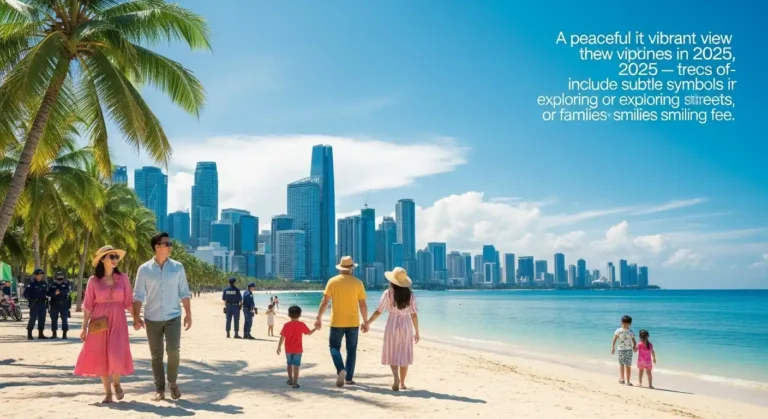Why Budapest is Europe’s Most Walkable City (And What to See!)
Budapest isn’t just a city you visit—it’s a city you feel with every step. From riverside walks to castle climbs and café-lined streets, exploring on foot here turns travel into pure magic.
Budapest offers an easy and enjoyable way to explore on foot. In the old Jewish neighborhoods of Pest and around the city centre, you will find smooth pavements and clearly marked pedestrian crossings with traffic lights that keep movement safe and simple. Many routes connect beautiful tourist attractions within short distances, making it perfect for walking.
The public transportation system is well connected, so you can switch between walk, trams, buses, and the subway with ease. Google and Apple Maps provide clear directions, helping you find the best connections. A taxi is also an option, but most places are close enough to enjoy at your own pace.
- Walkability: Budapest is highly walkable, especially in Pest with its flat terrain, wide boulevards, and pedestrian-friendly zones. Many attractions are close together.
- Scenic Routes: The Danube Promenade, Margaret Island, Castle Hill, and Andrassy Avenue offer some of the most beautiful walking experiences.
- Buda vs. Pest:
- Pest: Flat, lively streets with cafés, nightlife, markets, and the Jewish Quarter.
- Buda: Hillier, with castles, panoramic views, historic sites, and thermal baths.
- Public Transport: Well-connected trams, buses, and metro complement walking; taxis are available but not always necessary.
- Best Walking Spots: Castle Hill & Buda Castle District, Danube Promenade & Chain Bridge, Jewish Quarter & ruin bars, Andrassy Avenue to Heroes’ Square.
- Itineraries:
- 1-day: Covers main highlights like Parliament, Buda Castle, Fisherman’s Bastion, Heroes’ Square, and Basilica.
- 2–3 days: Adds thermal baths, nightlife, food/wine experiences, and more cultural landmarks.
- Unique Walks & Tours: Options include themed walks (Jewish Quarter, Art Nouveau, Castle Hill), food tours, memorial visits (Shoes on the Danube), and creative experiences like vampire tours.
- Practical Tips: Best walking seasons are spring and autumn; wear comfortable shoes; pack layers, swimsuit, and essentials.
- Family & Accessibility: Many routes are stroller- and wheelchair-friendly, like Margaret Island, Danube Promenade, and Castle District.
- Safety: Budapest is generally safe, even at night. Be mindful of pickpockets, taxi scams, and tourist-targeted dining tricks.
- Traffic Rules: Pedestrian crossings are safe and well-marked; follow signals and visibility tips for safety.
Can You Explore Budapest on Foot?
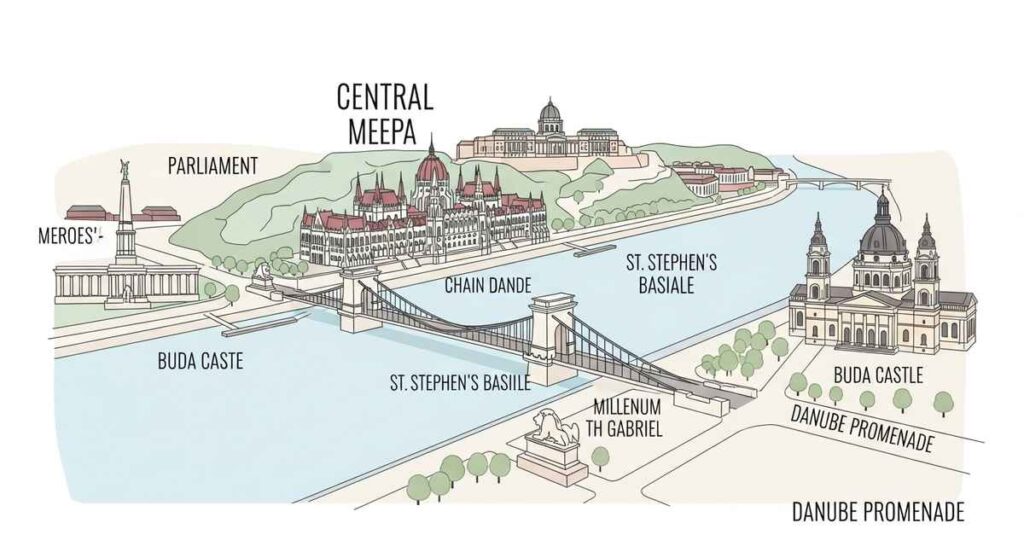
Budapest is a walkable city, full of charm and surprises. Strolling by the Danube and its water feels amazing, as you can bask in the beauty of gorgeous architecture and enjoy the energetic atmosphere. The mix of shiny surfaces, leafy suburbs, and frantic roundabouts makes the walk even more exciting.
You may come across climbing frames for dogs, vending machines for books, and enjoy fast food or a deliciously prepared brunch along the way. A grand synagogue and every bridge you step over add to the city’s character, making walking the best way to gain a true appreciation of Hungary.
Walking here doesn’t just take you from place to place—it lets you feel the city.
Why Budapest is One of Europe’s Most Walkable Capitals
Budapest is one of Europe’s most walkable capitals because of its flat terrain, pedestrian zones, and scenic riverside walks. The Pest side offers wide boulevards, promenades, and walkable attractions clustered close together.
Combined with an efficient public transportation system, beautiful architecture, and diverse experiences like thermal baths, cafes, and ruin bars, exploring Budapest on foot is both comfortable and enjoyable.
Flat Terrain and Easy Walking
On the Pest side of Budapest, the terrain is mostly flat, which makes walking simple and comfortable. The city layout with wide boulevards and long riverside promenades gives plenty of space for pedestrian-friendly areas. Exploring on foot feels natural here, with many attractions close together, making it possible to see several sites in a single walk.
Riverside Walks and Pedestrian Zones
The Danube River adds charm with scenic routes on both sides. Riverside Walks give views of iconic landmarks like the Parliament Building and the Chain Bridge. Some areas, like Margaret Island, are car-free green spaces perfect for recreation and leisure. These Pedestrian Zones make the city both relaxing and inspiring for exploration.
Efficient Public Transportation
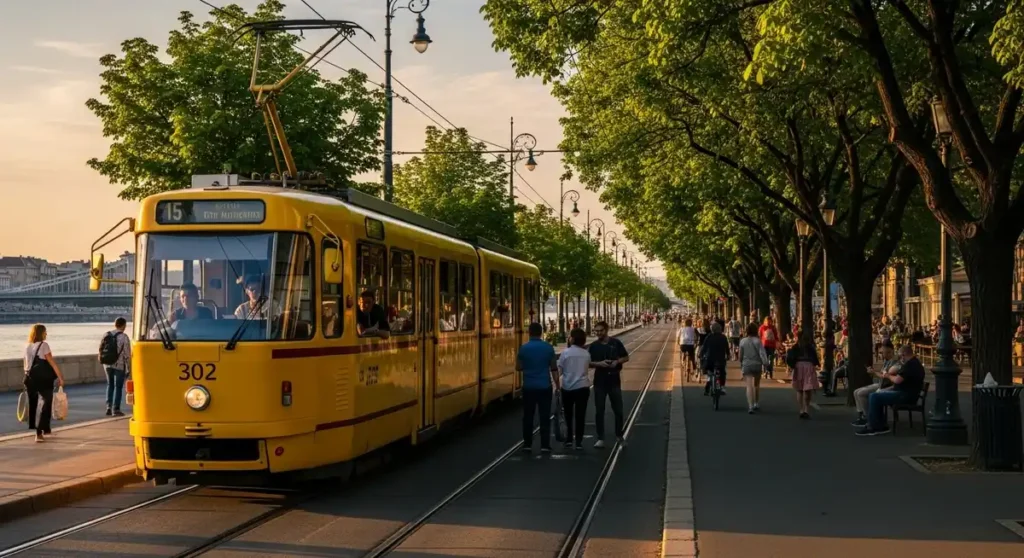
The public transportation system in Budapest is well-connected with metro, trams, and buses, allowing easy travel between districts. It works smoothly with walking, letting visitors enjoy both nearby and distant parts of the city center.
Architecture and Diverse Experiences
The beautiful architecture, from historic buildings to grand boulevards, creates an inviting atmosphere for exploration. The walkable attractions are often clustered, so every step brings new sights. Alongside walking, diverse experiences like soaking in thermal baths, enjoying local cafes, or discovering ruin bars make the journey even more rewarding.
Buda vs Pest – Which Side is Better for Walking?
Both Buda and Pest are perfect for walking in different ways. Buda has peaceful hills, castles, and panoramic views, while Pest offers lively streets, cozy cafés, and vibrant nightlife. Together, they make Budapest one of the best cities in Europe to explore on foot.
Walking in Pest – Flat Streets, Cafes & Nightlife
On the Pest side of Budapest, the flat plain makes walking easy and inviting. The Parliament building, standing by the Danube River, adds grandeur to the eastern city. Walking here feels like stepping into history, with stories from Roman settlements, the Habsburg rule, and the great joining of Buda, Pest, and Óbuda in 1873.
The streets are lively, filled with cafés, restaurants, and small boutique shops. The Central Market Hall is full of colors, with local treats like paprika and sweet pastries. On Váci Street, you can find unique souvenirs and charming corners to rest and enjoy the scenery.
The Jewish Quarter adds a special touch, with the Gozsdu Courtyard, Dohány Street Synagogue, Jewish Museum, and the Holocaust Memorial. From the observation deck at Saint Stephen’s Basilica, sweeping views of the Chain Bridge, the skyline, and the Danube make the walk unforgettable.
Walking in Buda – Hills, Castles & Panoramic Views
The Buda Castle Quarter, a UNESCO World Heritage site, is filled with historic buildings and timeless landmarks. On Castle Hill, the Buda Castle, Matthias Church, and the Fisherman’s Bastion with its neo-Gothic terrace showcase rich architecture.
Walking here gives you panoramic views of Budapest, from the Parliament building to the Chain Bridge. Guided by experts, you learn stories and historical insights while moving at a steady walking pace. Many photo stops capture the beauty of the scenery, and options for small group tours or even wheelchair accessibility make the experience open to everyone.
Buda vs Pest – Which Side is Better for Walking?
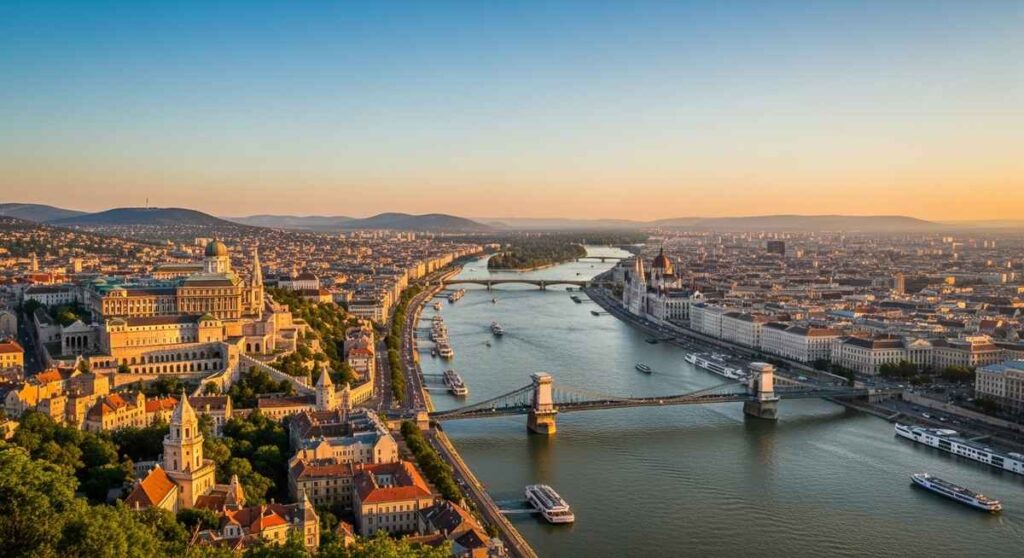
Budapest, known as the Pearl of the Danube River, blends the best of both sides. From Gellért Hill, the geographical difference is clear: Buda’s terrain is filled with green hills, while Pest stretches as a welcoming flat city.
Locals and tourists enjoy each side for different reasons. Buda is classier, with residential areas, thermal spas like Gellért Baths and Rudas Baths, and grand landmarks such as the Liberty Statue. Pest shines with its Opera House, Heroes’ Square, Széchenyi Baths, the Budapest Zoo, and Vajdahunyad Castle.
When evening comes, Pest transforms with vibrant nightlife. The ruin bars, cozy wine spots, lively breweries, and welcoming clubs in the Party District around District 7 make walking here full of energy. From botellón gatherings at the Basilica to peaceful cruising along the bridges, every step feels alive.
As a tourist, I found joy in both. The lookout points and museums in Buda are easy to cover in a day, while the pedestrian streets and markets of Pest offer endless discoveries. Whether for a short trip or a long-term stay, both sides of BudaPESCHT bring out the beauty of Eastern Europe with every walk.
The 4 Best Places to Explore on Foot in Budapest
1. Castle Hill & Buda Castle District
High above the Danube River in the 1st district rises Castle Hill, or Várhegy. At its heart is the grand Buda Castle, also called Budavári Palota, Burgpalast, the Royal Palace, Királyi-palota, Királyi Vár, or Königliche Burg. This historical palace complex now holds the Hungarian National Gallery, the Budapest Historical Museum, and the National Széchényi Library.
The Castle Quarter (Várnegyed) is a UNESCO World Heritage Site. It is filled with medieval, Baroque, and neoclassical houses, elegant churches, and striking monuments. Important landmarks here include the Sándor Palace, the Carmelite Monastery, and the beautiful Matthias Church.
Nearby, the Fisherman’s Bastion delights with its turrets, terraces, and views over the city. From the Holy Trinity Square, visitors see the Buda Hills, Rose Hill, and even traces of Roman history.
The Clark Ádám Square and Funicular link the Széchenyi Chain Bridge directly to the Castle District, making it easy to reach. Walking through this area means enjoying cobblestone streets, charming neighborhoods, and sweet stops like Ruszwurm. With its timeless landmarks, scenic vantage points, and inviting paths, it remains one of the most loved places for travellers in Budapest.
2. Danube Promenade & Chain Bridge
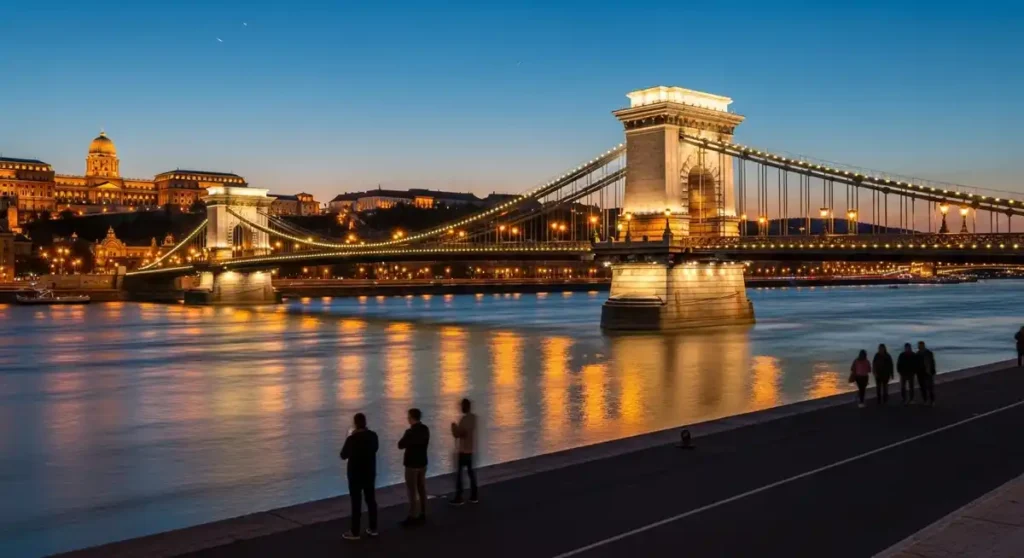
The Danube Promenade or Dunakorzó runs along the Pest side of the River. From here, you can see the Széchenyi Chain Bridge, the Erzsébet Bridge, and the skyline of Buda and Pest. The walkway connects grand landmarks and creates a peaceful space for strolling by the water.
The lánchíd, or Chain Bridge, opened in 1849. Designed by William Tierney Clark and built by Adam Clark, it was the first permanent bridge across the Danube. Its stone towers, sweeping chains, and lion statues make it a true marvel of engineering and architectural elegance.
Along the esplanade, you’ll pass the Vigadó concert hall, the Little Princess statue, the Girl and dog statue, and views of the Hungarian Parliament building. With cafes, bars, and boat restaurants, it’s a favorite for both locals and visitors. The atmosphere is full of charm, with a warm breeze and vibrant ambiance.
As evening comes, the illuminations light up the suspension bridge, turning it into a glowing scene of urban life. Whether enjoying quiet walks or watching cultural gatherings, this riverside route captures the beauty and spirit of Budapest.
3. The Jewish Quarter & Ruin Bars
The Jewish Quarter in Budapest is one of the most exciting places in the city. This lively area in Erzsébetváros, also called District VII, is filled with nightlife, colorful venues, and creative energy. Here you can enjoy ruin bars that turned old buildings into bright and vibrant spaces.
Szimpla Kert, opened in 2002, started the concept of ruin bars. Its playful decor, with vintage furniture, artistic decorations, and open spaces, created a warm and unique place for everyone. Other popular names like Mazel Tov and Kőleves on Kazinczy Street welcome people with live music, fun events, and an artistic atmosphere.
The Quarter also shines with cultural landmarks such as the Dohány Street Synagogue. Around it, you find cafes, restaurants, stylish boutiques, and even avant garde galleries. It is the heart of the city’s social life, where people share food, music, and stories, making every visit an unforgettable experience.
4. Andrassy Avenue to Heroes’ Square

Walking along Andrássy Avenue feels like stepping into history and beauty. This grand boulevard connects the city center with the City Park. In the 19th century, Prime Minister Count Gyula Andrássy transformed the area into a place of elegance. Influenced by Paris, his ideas and architects shaped an opulent symbol of Hungary’s strength and happy peacetime.
The avenue is lined with treasures such as the State Opera House by Miklós Ybl, the secessionist Párizsi Nagy Áruház, the House of Terror museum, the Hungarian University of Fine Arts, the Ferenc Liszt Memorial Museum, and the Ferenc Hopp Museum of Asiatic Arts. Landmarks like the Oktogon and Kodály körönd mark its flow, while the underground railway, with charming stations, adds even more character to this UNESCO World Heritage site.
At the end lies Heroes’ Square, the gateway to the City Park. It features a tall column with the Archangel Gabriel, surrounded by statues, monuments, and arcades. Here, the work of sculptor György Zala and the design of Albert Schickedanz create a masterpiece.
The Hall of Art and the Museum of Fine Arts frame the square, where visitors admire great masters such as Raphael, Leonardo, Dürer, Pieter Bruegel, Rembrandt, El Greco, Goya, Renoir, Toulouse Lautrec, Gustave Courbet, Claude Monet, Édouard Manet, and Auguste Rodin. With its rich collection, inspiring exhibitions, and world-class shows, it is a favorite for art aficionados.
Walking Itineraries for Every Traveler
1-Day Walking Itinerary
A 1-Day Walking Itinerary in Budapest lets you see top highlights like the Parliament, Buda Castle, Heroes’ Square, Fisherman’s Bastion, and St. Stephen’s Basilica in one day. With smart planning, you can enjoy famous landmarks, relaxing thermal baths, lively nightlife, and hidden gems while keeping enough time for photos and local explore moments.
The Pearl of the Danube is full of allure. Visitors find beauty in its grand landmarks and warm thermal baths, while the nightlife adds sparkle after a long day. Every traveler can design a simple guide or itinerary to match personal needs and interests.
Along the way, there are local recommendations, less touristy places, and cultural gems that make the journey rich. The historical monument walks and stops at each museum give depth to the experience.
I often suggest a smooth program that mixes must-see attractions with easy rides by taxi. The main sites—Parliament, Heroes’ Square, Fisherman’s Bastion, Buda Castle, and St. Stephen’s Basilica—are close enough to enjoy in a short trip.
In Europe, these highlights stand among the best. The driver usually waits, making it simple to take photos and enjoy each stop. The average cost is about 16 USD per hour, which is fair for the time saved.
Other wonderful landmarks include the Hungarian Parliament Building, the moving Shoes along the Danube, and the elegant Hungarian State Opera.
2–3 Day Walking Plan
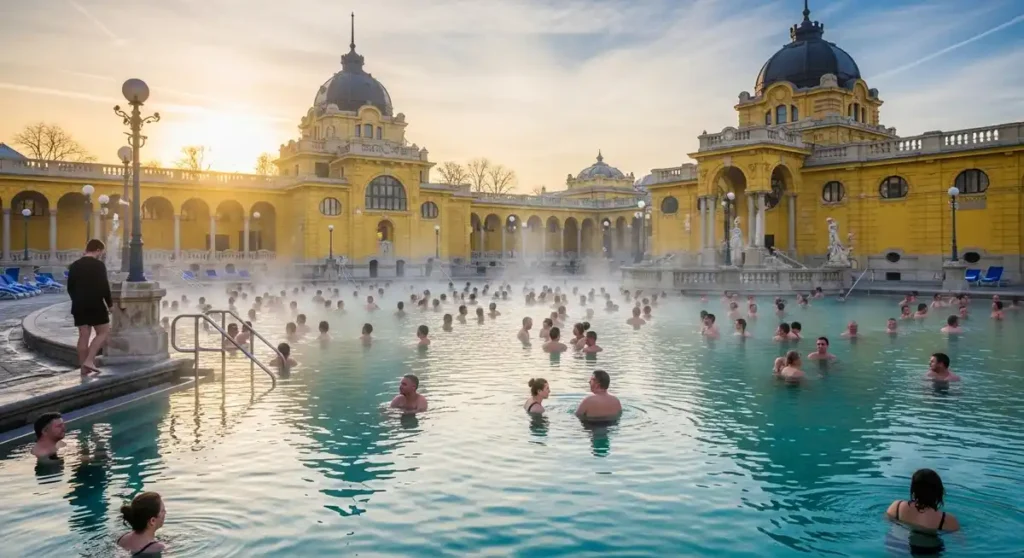
A 2–3 day walking plan in Budapest is the best way to enjoy the famous sites, soak in thermal baths, explore Buda and Pest, and taste local food and wine. With its architecture, history, and vibrant culture, the capital of Hungary offers a perfect short break for any visitor.
On my first trip to Budapest, I felt the warmth of the city right away. It became like a home, full of love, charm, and energy. I made a simple plan for a few days and built a comprehensive itinerary for a first-time visitor.
I explored the famous monuments, iconic sites, and special areas that make Budapest unforgettable. I also mixed in my own favorite places, enjoying an array of both big highlights and well-known gems. This balance gave me the essence of the European city beyond just the tourist points.
Budapest is an underrated gem in Central Europe. As the capital of Hungary, it is beautiful, unique, and full of culture. The architecture, nightlife, interesting history, and thermal baths make it an ideal destination.
In 2–3 days, I was able to soak in the baths, enjoy stunning views of both Buda and Pest, and even add some wine and food stops from my bucket list. The small city is easy and quick to explore, so it felt simple to spend mornings and afternoons enjoying more without rushing.
A weekend trip here, mapped with care, means enjoying restaurants, a good drink, and the kind of cultural mix that makes Budapest truly fascinating for all visitors.
Themed Walks
Themed Walks in Budapest let you enjoy the city’s history, architecture, and culture through guided walking tours. From the Jewish Quarter and Castle Hill to Art Nouveau palaces, Margaret Island, and Váci Utca, each walk offers unique landmarks, heritage, and local experiences.
Joining themed tours in Budapest is one of the best ways to explore the city on foot. Each walking route has its own charm—whether it’s Art Nouveau highlights like the Royal Post and Gresham Palace, or the lively Jewish Quarter with its famous ruin bars and vibrant nightlife.
I also loved walking through Castle Hill, a UNESCO World Heritage site filled with medieval monuments, museums, and the grand Buda Castle. Strolling across the bridges of the Danube gives you stunning views, while Margaret Island is perfect for a peaceful hike or a simple loop walk. If you like city energy, Váci Utca is ideal for shopping and sightseeing.
Unique Experiences on Foot
- Visit the Shoes on the Danube Bank memorial for an important piece of heritage.
- Try a food tour in Pest to taste local flavors.
- Explore thematic trails like the Hungarian National Blue Trail (OKT), a long-distance route through Hungary.
- Join fun adventures like the Vampire Walking Tour, mixing folklore, undead legends, and adventure.
Most guided tours last a few hours, often with free options where participants give a small tip in USD. I once tracked a walk on my Garmin Forerunner Running Watch during a vacation, and it showed how easy and convenient it is to see so many attractions as a pedestrian. Every trip feels like a mix of art, heritage, characters, and real experiences, leaving you with photos and memories worth sharing as a recommendation.
Practical Tips for Walking in Budapest
Best Time of Year for Walking
Spring (April, May)
The weather is mild, comfortable, and fresh, with temperatures ranging from 10-20°C (50-68°F). The city feels alive with blooming flowers, greenery, and gorgeous gardens. It’s a beautiful backdrop for walks, concerts, and the Budapest Spring Festival, which fills the city with music, opera, jazz, and other cultural events.
Autumn (September, October)
In autumn, the fall foliage looks stunning, especially in the Buda Hills, parks, and downtown. The Pálinka and Sausage Festival in the Castle District offers local foods, fruit brandy, and a lively gastronomic atmosphere. Art Market Budapest also brings inspiring pieces from across the globe, while October 23 marks an important national holiday.
Summer (June-August)
Summer in Budapest is lovely, with warm, sunny days perfect for outdoors and leisurely walks. The city is full of life, and it’s a great time to explore the streets and enjoy open-air events.
Winter (November-March)
Winter is magical with Christmas markets in December, offering a unique experience with special foods and festive atmosphere. For those who enjoy the season, snowy streets make the city look like a fairytale.
What to Wear & Bring
A trip to Budapest is best enjoyed on foot. The city is walkable, and with the right pair of comfortable shoes, your feet will feel fresh all day while exploring. Whether you use public transport or a taxi, you will still walk a lot, so it helps to pack wisely.
Carry clothes, toiletries, and a small kit with medicine and accessories. Add electronics like a charger and adapter. These essentials make the travel smooth and enjoyable.
JACKET
A jacket is perfect for changing seasons in Budapest. In Autumn or Spring, a waterproof coat is the best choice. During Winter, a proper coat is a must to stay warm.
In Summer, a light cardigan for evenings is enough. No matter the season, it feels good to have layers when visiting.
T-SHIRTS
Bring T-shirts for every season. In Summer, short sleeve shirts are ideal. In Winter, long sleeve ones are better. During Spring and Autumn, it is easy to layer with cardigans. Pack a few to stay comfortable and sure for any trip.
JEANS
A pair of jeans is always a classic choice. You can pack them for any season in Budapest. They are good for day wear, and I recommend having at least one pair on every trip.
DRESS/SMART OUTFIT
For evenings, it feels special to have a smart outfit or dress. In Budapest, the river cruises, theatre shows, and cultural events are great. A fancy, elegant outfit makes a special occasion more memorable. I always pack one, and it works well for a celebrate night out.
SHORTS/SKIRTS
In the hot summer months from May to September, shorts and skirts are perfect. They keep you cool when planning to visit outdoors. I always pack some for anytime the weather is bright.
SWIMSUIT
The thermal baths in Budapest are a highlight. A swimsuit is a must for a trip to a pool or hotel spa. I always bring my own, as it feels better and gives me more options. It is fun to stay and enjoy swimming or relaxing in the chill waters.
FLIP-FLOPS
Flip-flops or slippers are very useful for the thermal baths. They are easy to pack and make walking around more handy. I also carry a towel and sometimes extra towels for comfort. They are light, easy, and make the visit more relaxed.
Clothing and Accessories
For exploring the city, I wear lightweight, breathable clothing and comfortable shoes. Sun protection is important, so I bring a hat, sunglasses, and sometimes an umbrella in case of rain.
In cooler hours, a sweater or light jacket keeps me cozy. For evening dining or sightseeing, a smart attire is a good choice.
Travel Essentials
Some things make every trip smoother. A reusable water bottle, sunscreen, and toiletries are essentials. I keep my smartphone and camera close for capturing memorable moments.
A portable charger, travel-sized bag for toiletries, and a European adapter for outlets keep my devices ready. These essentials make every walk in Budapest enjoyable and full of great memories.
Accessibility & Family-Friendly Walking Routes

Accessibility & Family-Friendly Walking Routes in Budapest make exploring the city easy for everyone. With flat paths, open spaces, and scenic spots like Margaret Island, the Danube Promenade, and Buda Castle District, visitors with strollers, mobility aids, or children can enjoy safe and comfortable walks.
Exploring Budapest is a joy because the city has many accessible and family-friendly walking routes. These areas are navigable and welcoming for families with children, people using strollers, or those needing mobility aids. Strolling through the city feels both relaxed and enjoyable, especially near the Danube, Margaret Island, or the historic Buda Castle.
The large island in the Danube is one of my favorite places for paved paths, green spaces, and recreational facilities. It is ideal for family outings and leisurely walks, offering a calm atmosphere right in the heart of the city.
Along the Danube Promenade, you can find scenic views of the River and the Buda side of the city. The wide, flat path is easy for everyone to enjoy. Nearby, the castle district offers more accessible areas, with highlights like the Fisherman’s Bastion, which gives stunning views across Budapest.
Other places to explore include Gellért Hill, where the main path to the Citadel is well-maintained and suitable for different fitness levels. The Jewish Quarter provides step-free entrances and lifts, making it open and welcoming.
For a lively atmosphere, Váci Utca is a pedestrian street full of a vibrant mix of walking and shopping. If you prefer nature, the family-friendly trail at Normafa and János Hill in the Buda mountains offers beautiful views and is relatively easy to navigate.
With good planning, you can enjoy the beauty, surroundings, and charm of Budapest. Every travel site or route brings ease and comfort, making this city a perfect choice for families and visitors of all ages.
Safety When Walking in Budapest
Is Budapest Safe to Walk at Night?
Budapest is a safe city to walk at night, especially in well-lit and busy areas like the city center, Váci Street, and around the Parliament building. The nightlife is vibrant, with bars, restaurants, and ruin bars full of locals and tourists, making the atmosphere lively and enjoyable.
When you take an evening walk in Budapest, you will notice the streets are often brightly lit, and the bridges, architectures, and the moon create a beautiful view. The city center and party district are filled with crowds, partygoers, and a mix of travelers enjoying the nightlife scene.
Exploring the Pest-side makes the trip memorable, as you pass through nightclubs, late-night restaurants, and unique venues that give the town its energetic charm. Whether enjoying the glow of historic buildings or the buzz of tourists and locals, Budapest offers a safe and welcoming experience for anyone enjoying the night.
Common Scams & How to Avoid Them
Walking in Budapest is a beautiful experience. The city is full of history, culture, and charm. Knowing a few tips about scams makes your visit smoother and more enjoyable.
Pickpockets
Pickpocketing is a common petty crime in many big cities. In Budapest, the crime rates are low, but it’s still wise to guard your belonging and valuables. Keep things close in crowded places like bars or public transport.
Taxi Scams
When you hail a taxi, choose trusted companies. Drivers from Uber, Bolt, CityTaxi, or Főtaxi follow clear regulations and fares. They are well established in the Hungarian market. Always verify the taxi’s license and branding before your journey. Travelers who book through apps enjoy safe rides and full confidence.
Dining Scams to Avoid
The dining scene in Budapest is vibrant. Most restaurants offer authentic culinary offerings, but some may use tourist pricing. Check the menu before you order, and notice any service charges on the bill. Reading online reviews, especially from locals, helps you enjoy genuine food without surprises.
Trusting All Taxis
Budapest taxis are yellow, but some have a company logo while others show freelancer. For peace of mind, choose the regulated taxis with a logo. It keeps your ride smooth and prevents feeling ripped off.
Not Using Public Transportation
The public transportation in the city is one of Europe’s best. Try the Metro or trams when not walking. They are affordable and easy to use. Buying a single-day or multi-day ticket is a smart choice—just don’t forget to stamp before you board.
Thinking Gellért Is the Only Bath in Budapest
Budapest has over 100 hot springs and famous medicinal baths. While Gellért is popular and much photographed, many smaller bath houses give a calm experience. Ask your hotel for a recommendation to explore beyond the main spots.
Getting Upset at the Service
Service in Budapest is relaxed. Staff are friendly and helpful, though sometimes slow. Preparing your order before the server returns keeps your meal smooth.
Not Having Local Currency
In Budapest, the currency is the Hungarian Forint. Some places accept Euros, but it’s better to carry cash. Use an ATM to withdraw wisely. Avoid the default option with high numbers and let your bank handle the conversion. For good transactions, use banks or exchange offices instead of a stranger.
Avoiding Paprika & Sour Cream
Hungarian cuisine shines with ingredients like paprika and sour cream. Expect food that is hearty, heavy, with soups, chicken dishes, and rich sauces. Though you’ll see Italian restaurants, the local meals are truly delicious.
Having Too Much Palinka
The city’s nightlife adds to its charm. Palinka is a schnapps from Hungary, with many flavors like pear, plum, and cherry. It’s fruity, so enjoy slowly. Keeping your interests in mind makes it a fun part of your traveling.
Not Leaving Budapest
Beyond Budapest, there are great attractions. Visit Roman ruins, explore underground caves, or relax in other baths. The city is the start, but the countryside adds more to see.
Staying Near Parliament
The Hungarian Parliament Building is truly breathtaking at night. The town offers wonderful views from across the river, making it one of the safest and most enjoyable experiences in Budapest.
Falling for These Tourist Scams
In a touristy city, a few scams exist. Some tourists meet the Damsel in Distress trick, where a woman buys a drink and leaves a bar tab behind. The Menu Mix-Up is another, where the prices on one menu differ from the bill.
To avoid surprises, be specific when ordering drinks or food. Stick to Taxi services from freelancer-free companies to avoid ripping issues. Ask your hotel about fair price expectations. Sometimes, people offer gifts on the street and then ask for pay. And like all big cities, stay mindful of pickpockets.

Pedestrian Crossings & Traffic Rules
Walking in Budapest is simple when you know how to cross the roads the right way. At designated crossings, the traffic lights show when it is safe to proceed. When the light is green, pedestrians can move with confidence. I often notice how easy it feels to walk here when everyone follows the crossings and signals.
Sometimes a flickering green light indicates that it is time to quickly finish walking. At other places with no crosswalks, it helps to ensure the way is clear without impeding vehicles.
As PTE ÁOK highlights, being aware of your visibility is very important, particularly at night or in low conditions. I often consider wearing reflective clothing, which makes walking in both built-up areas and outside spaces more comfortable.
There are also Other Important Rules that keep people and drivers safe. Walking without delay, avoiding actions that may confuse or disturb, and giving thought to Safety makes the streets pleasant for everyone. The Right of Way is respected, and pedestrians are generally given space when turning onto a main road at a designated crossing.
Is Budapest Walkable for Tourists
Budapest is very walkable for tourists. Most main attractions are close together, easy to reach on foot, and supported by excellent public transport for longer distances.
Budapest is a peaceful city where travellers and foreigners can enjoy a safe visit. The main attractions are within short walking distance, making it simple to explore around the place. Streets are easy to move through, and the public transport gives fast access when needed.
I loved walking on the Buda side, especially near the Gellért Hill, where the view was beautiful. It shows why Hungary is known as a country that welcomes all nationalities from around the world. With very low crime rates, it feels completely safe to explore, even now, whether you are here for the first time or returning as a traveller.
Conclusion
Exploring Budapest on foot is both easy and rewarding. The city centre has smooth pavements for pedestrians and well-marked pedestrian crossings with traffic lights, making walking safe and simple. Many tourist attractions are close to one another, so it’s easy to get around without needing much transport.
For longer trips, the extensive public transport helps. There are metro lines, buses, trams, trolley buses, and HÉV trains. If you prefer, taxis provide a comfortable and quick option.
Beyond transport, the joy comes from the sightseeing itself. Every step feels like part of a story as the experience blends history, beauty, and everyday life. You can wander Pest’s wide boulevards or climb the Buda hills. With good shoes and a little curiosity, each walk will reveal something new about this unique city.
FAQs About Walking in Budapest
Is it easy to walk around Budapest?
Yes, it is very easy to walk around Budapest. The streets are flat, smooth, and full of safe crossings. Many attractions are close together, so walking feels simple and enjoyable.
Is it easy to get around Budapest?
Yes, getting around Budapest is easy. You can walk, take the metro, trams, or buses. Maps on your phone make it simple to plan. Taxis are also available if needed.
Is 3 days in Budapest too long?
No, 3 days is just right. You can see the main sights, enjoy baths, explore both Buda and Pest, and try local food. It gives time to relax without rushing.
Can you jaywalk in Budapest?
It is better to cross at marked crosswalks with green lights. The signals are clear and safe for walkers. People usually follow the rules, and it keeps walking simple.
Can I walk everywhere in Budapest?
Yes, you can walk to many places. The main sights like Parliament, Castle Hill, and the Danube are close together. Walking is the best way to enjoy the city’s beauty.
Can you get around Budapest without a car?
Yes, you do not need a car in Budapest. Walking and public transport cover the city well. Trams, buses, and metro are fast and easy to use.
Is Budapest friendly to American tourists?
Yes, Budapest is very friendly to American tourists. Locals are welcoming, and English is widely spoken in tourist areas. Visitors feel safe and comfortable.
Is Budapest pedestrian friendly?
Yes, Budapest is very pedestrian friendly. It has wide boulevards, riverside walks, and car-free zones. Paths are clear, safe, and great for exploring on foot.
What’s the best way to get around Budapest?
The best way is to walk and use public transport. Walk for short distances, and use trams or metro for longer trips. It is cheap, quick, and easy.
Do and don’ts in Budapest?
Do enjoy local food, baths, and walks by the Danube. Do carry local currency for small shops. Don’t forget to check menus before eating. Don’t take unlicensed taxis.
Is Budapest flat or hilly?
Pest is flat and easy to walk, while Buda has hills with castles and views. Together, they make walking both simple and exciting.
Can I walk from Buda to Pest?
Yes, you can walk from Buda to Pest. Several bridges cross the Danube, like the Chain Bridge. The views while walking across are beautiful.
Disclaimer
This travel guide is based on research and personal experiences. Information may change over time, so please double-check details before your trip. Traveldrizzle.com is not responsible for any changes, closures, or local updates that may affect your visit.






